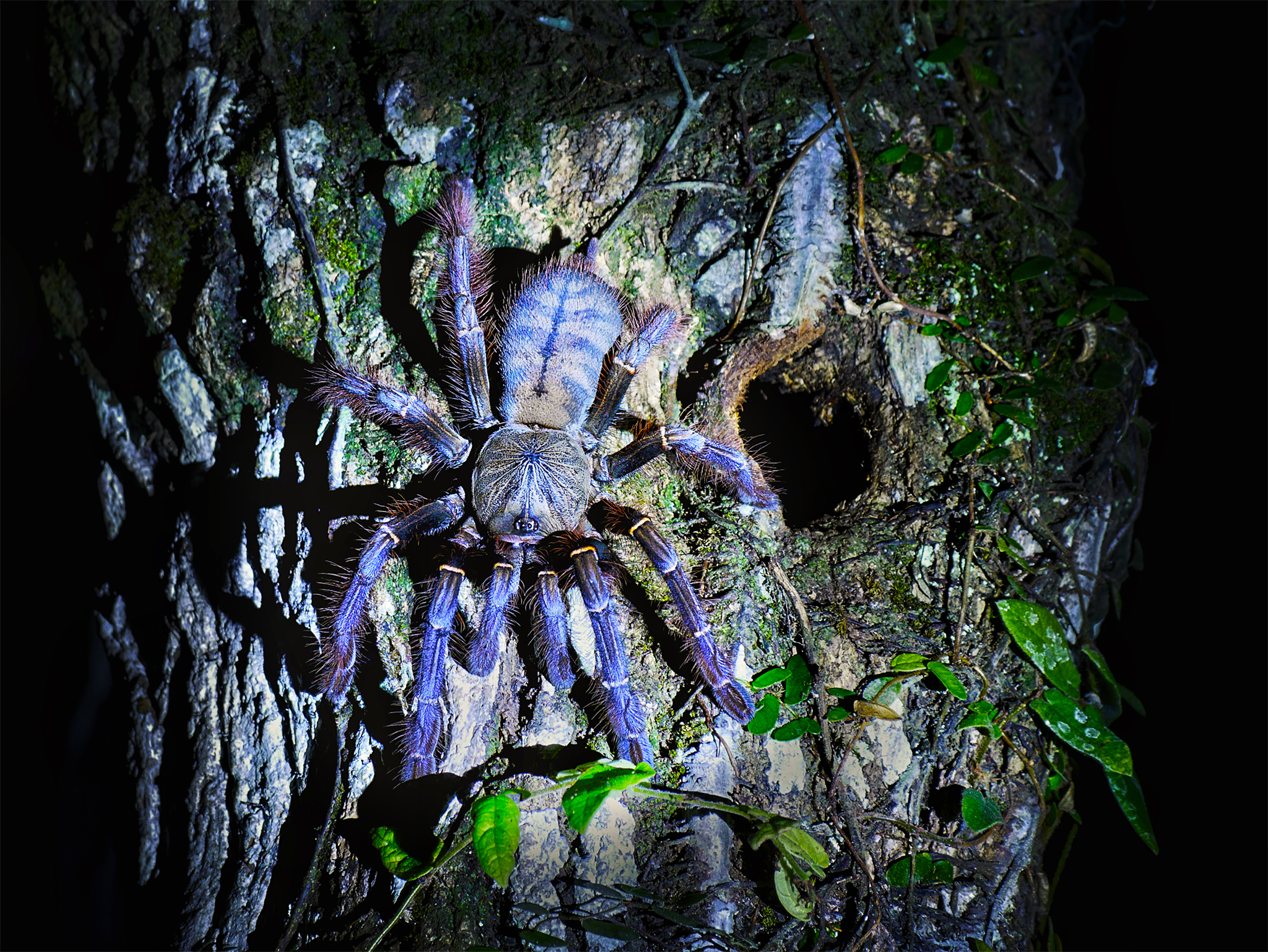Two days after landing in Borneo, and a week before arriving in the mystical Danum Valley, I was sitting at a café flicking through the pages of a hardcover collection of Bornean wildlife photography. I remember seeing an image of a giant spider with bright, neon blue legs and questioning whether such a creature actually existed. Next to the image was a simple caption – “Blue-Legged Tarantula, Danum Valley”.
Jump forward a week later and I’m on a night walk through the jungles of the Danum Valley.
Strolling through a pitch-black jungle is invigorating. The rainforest comes to life at night. The noise from all around envelopes you. Your senses are heightened, the hairs on the back of your neck stand up. You feel vulnerable – truly a visitor, and at the mercy of the jungle.
As you shine your torchlight into the darkness, hundreds of tiny lights shine back at you. Each is the reflective spot on top of a spider. Bioluminescent mushrooms, flying frogs, camouflaged cats and wide-eyed owls. None of it quite seems real.
“I saw a picture of a tarantula from around here that had neon blue legs. Have you seen one before?” I asked the guide.
“She lives near your lodge, I’ll show you her nest when we get back,” he replied.
Sure enough, as we were walking back to the accommodation, the guide pointed out large hole in the trunk of a nearby tree.
“She’s very shy, you’ll have to keep an eye out for her.”
The first two nights were unsuccessful, just an empty hole for all I knew, and I began to wonder if the tour guide was having me on – laughing to himself having tricked the hapless tourist.
But on the third night, I came back and caught my first glimpse of this eerily magical creature, her front legs creeping their way out of the nest, waiting for an unsuspecting grasshopper or cockroach to come crawling up the wrong tree.

I came away contented with the photograph, but was to have even more luck the following night.
I was due to leave the Danum Valley the next morning, and as I was heading back to my room for the evening I decided to stop by the tarantula’s nest one final time. As I peered through the darkness towards that hole in the tree, I couldn’t believe my luck.
The tarantula was out, sitting right next to her nest, posing precisely for the camera. She decided to sit there, perfectly still, for over an hour while I was photographing. I was still new to photography at this point, I didn’t even have a macro lens for close ups – so I ended up putting my telephoto lens on a tripod, setting the exposure for a few seconds, and then painting the light onto the spider with my headtorch. It was a slow but effective way of photographing this gorgeous tarantula.

Sadly however, like many eye-catching tarantulas, her beauty may in fact be her downfall. Those incredible neon blue legs make her a hot target for the exotic pet trade, which threatens rare tarantulas across the globe, and has seen a number of species afforded protected status by international wildlife conservation organisations. The demand for rare and esoteric spiders can lead to some species going extinct before we even know they exist. If you’re determined to have a tarantula as a pet, always ensure you are purchasing from a sustainable and reputable breeder.
Tarantulas are commonly split into ‘Old World Tarantulas’ (those from Asia, Africa and Europe) and ‘New World Tarantulas’ (those from the Americas), with the primary difference being the presence of urticating hairs on the New World Tarantulas. If, like me, you have no idea what urticating means, it’s science for “don’t touch me or you’ll be in lots of pain”. A variety of plants and caterpillars also have urticating hairs, so “don’t touch me or you’ll be in lots of pain” is a solid rule for any hairy plants, caterpillars or spiders – no matter how much they look like they want a scratch behind the ears.

Old World Tarantulas like the one pictured still have hairs, but they won’t sting you. Instead, they rely primarily on their bite and venom for hunting prey. In general, tarantulas are pretty harmless to humans, and will leave you alone if you reciprocate the favour. If provoked or threatened, they can give you a nasty bite, but won’t do any long-term damage. Spiders have an undeserved reputation as scary or creepy, but much like the vast majority of animals on our planet, if you don’t hurt them, they won’t hurt you.
–
Purple Earth Tiger Tarantula (Phormingochilus sp.), Danum Valley, Borneo
*I actually think the one in the book might have been Birupes simoroxigorum, not tarantula photographed, but both are absolutely beautiful spiders.


